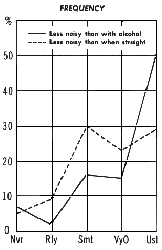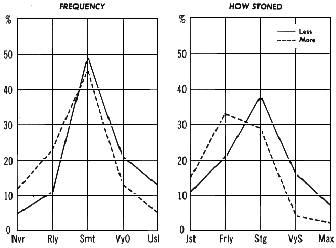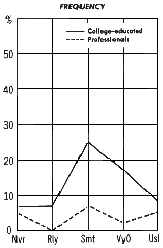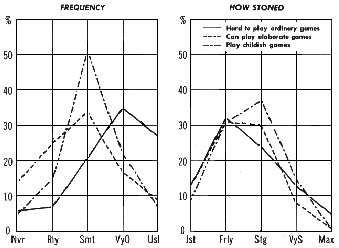
NOISINESS AT PARTIES

 |
| Figure 12-1. NOISINESS AT PARTIES |
 |
| Figure 12-2. AMOUNT OF TALKING WHEN INTOXICATED Note.—For guide to interpreting the "How Stoned" graph, see note on Figure 6-1. |
 |
| Figure 12-3. SOCIABILITY |
 |
| Figure 12-4 EDUCATIONAL LEVEL AND UNNOTICEABILITY OF INTOXICATION |
 |
| Figure 12-5 EXTERNAL BEHAVIOR INDICATIVE OF BEING INTOXICATED Note.—For guide to interpreting the "How Stoned" graph, see note on Figure 6-1. |
 |
| Figure 12-6. SOCIAL GAME PLAYING Note.—For guide to interpreting the "How Stoned" graph, see note on Figure 6-1. |
| ——Others do not notice I'm stoned—— | ——Others notice I'm stoned—— | ||||||||
| Just | Fairly | Strongly | Very Strongly | Maximum | |||||
| |||||||||
| MERGE, BECOME ONE WITH OTHERS | |||||||||
| PEOPLE'S FACS CHANGE | |||||||||
| OTHERS NOTICE I'M STONED | |||||||||
| Do antisocial things | |||||||||
| FORGET START OF SENTENCE | |||||||||
| AT ONE WITH THE WOPRLD | |||||||||
| THINK I'VE SAID SOMETHNG WHEN I'VE JUST THOUGHT IT | |||||||||
| FEEL ISOLATED | |||||||||
| CONVERSE INTELLIGENTLY EVEN THOUGH THINGS ARE FORGOTTEN | |||||||||
| FORGET START OF CONVERSATION | |||||||||
| FEEL PARANOID | |||||||||
| OTHERS STILL DO NOT NOTICE I'M STONED | |||||||||
| TELEPATHY | |||||||||
| People seem dead, like robots | |||||||||
| GIGGLE A LOT | |||||||||
| LEARN A LOT ABOUT WHAT MAKES PEOPLE TICK | |||||||||
| SIGNIFICANCE IN COMMONPLACE CONVERSATIONS | |||||||||
| LESS SOCIABLE | |||||||||
| TALK LESS | |||||||||
| PLAY CHILDISH GAMES | |||||||||
| STRONGLY INFLUENCED BY COMPANIONS | |||||||||
| EMPATHIZE MORE WITH OTHERS | |||||||||
| INSIGHTS INTO OTHERS | |||||||||
| SAY MORE PROFOUND, APPROPRIATE THINGS | |||||||||
| MORE SUBTLE HUMOR | |||||||||
| PLAY ELABORATE GAMES | |||||||||
| MORE GROUP FEELING | |||||||||
| ORDINARY SOCIAL GAMES HARD TO PLAY | |||||||||
| LESS NOISY THAN WHEN STRAIGHT | |||||||||
| TALK MORE | |||||||||
| MORE SOCIABLE | |||||||||
| HIGHER PEOPLE GET ME HIGHER | |||||||||
| LESS NOISY THAN WHEN DRUNK | |||||||||
| Just | Fairly | Strongly | Very Strongly | Maximum | |||||
| ——Others do not notice I'm stoned—— | ——Others notice I'm stoned—— | ||||||||
| BACKGROUND FACTORS | EFFECTS | |
|---|---|---|
| More Drug Experience | More frequent: People's faces change Less noisy than when straight Telepathy More subtle humor More intoxicated for: Talk more People haven't noticed I'm stoned Giggle a lot Forget start of conversation | Less frequent: Think said something when just thought it Feel paranoid Hard to play ordinary social games Less intoxicated for: Quieter than when straight Insights into others People seem like robots Say more profound things Play elaborate games Telepathy |
| Meditation | More frequent: People's faces change Merge with others Feel one with world More intoxicated for: Less sociable | Less frequent: Talk more Feel isolated Less intoxicated for: Feel paranoid |
| More Educated | | Less frequent: Ordinary games hard to play Less intoxicated for: Talk more Merge with others |
| Older | More frequent: People haven't noticed I'm stoned | Less intoxicated for: Talk more Merge with others |
| Males | More frequent: Strongly influenced by companions More intoxicated for: Forget start of sentence | Less frequent: Giggle a lot |
DRCNet Library | Schaffer Library